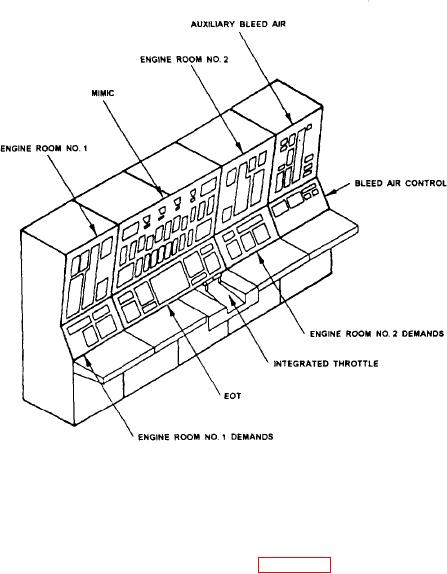
Figure 3-1.--PACC layout.
DD-963, DDG-993, AND CG-47 CLASS
The PACC contains electrical equipment that is
CCS OPERATIONS
capable of controlling and monitoring both propulsion
plants and most of the ship's auxiliary systems. Notice
On DD-963, DDG-993, and CG-47 class ships, the
in figure 3-1 how each panel of the PACC is dedicated
CCS is located remotely from the ship's machinery
to particular types of control and monitoring. In this
spaces. This design allows the engineering plant to be
section, we will briefly discuss the following control and
monitored and controlled with a minimum of personnel.
monitoring systems that are operated from the PACC:
The two major consoles that control the engineering
1. Fuel oil service system
plants on these ships are the PACC and the EPCC. The
PACC is the console in the ECSS where control of the
2. Lube oil system
propulsion plant and auxiliary systems is normally
3. Air system
located. The EPCC is the console where control of the
4. Gas turbine module (GTM) control
electric plant is normally located. On the CG-47 class
ships, the EPCC also controls and monitors the
5. Engine order telegraph (EOT) control
distribution of the ship's 400-Hz power. We will briefly
6. Throttle and pitch
discuss the operation of these two consoles in the
following paragraphs.
7. Plant mode
8. Auxiliaries
PACC
In the following paragraphs, we will provide a basic
overview of these systems. For detailed information,
The PACC is the central control point in the
consult the appropriate EOSS, EOP, and technical
propulsion plant's control system. The PACC monitors
manuals.
and controls the operation and performance of the ship's
main propulsion equipment and systems by sending
Fuel Oil Service System
commands that will operate specific controls to
sequence the operation of equipment or control
For the fuel oil service system, the control and
subsystem operation.
monitoring functions at the PACC can be divided into

